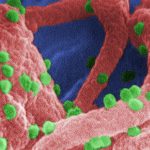The “Z” symbol was initially spotted on Russian tanks and other military vehicles but it has quickly been embraced by some as a show of support for Russia’s invasion of Ukraine.
Sky News looks at the possible origins of the symbol.
How widespread is its usage?
News reports on Monday alone had two examples of the symbol being used.
Terminally ill children in the Russian city of Kazan were encouraged to stand outside in the snow with their mothers to form the letter Z to show support for the invasion. The chairman of the cancer charity that runs the hospice said he used a drone to take the photo before posting it on the hospice’s website.
And Russian gymnast Ivan Kuliak will be investigated by the sport’s governing body after he wore the symbol on the podium after finishing third in the parallel bars at a competition in Qatar over the weekend. His Ukrainian rival Illia Kovtun, who won the gold medal, did not look impressed.
So where does it come from?
There are differing views on this.
Some say it is Z for За победу – pronounced “za pobedu” (meaning “for the victory”), others say it is for “Zapad” (West).
Ukraine war: Northern Irish businessman describes ‘incredible’ journey to Poland after collecting aid
Ukraine war: President Volodymyr Zelenskyy to make ‘historic address’ to British MPs tomorrow
Ex-Tory minister to step down as chairman of Russian aluminium business EN+
Many have noted its similarity to the swastika – the symbol used by Nazi Germany in the Second World War – nicknaming it “Putin’s swastika”.
A post shared by Минобороны России (@mil_ru)
The Russian defence ministry appears to have confirmed the first option.
In an Instagram post late last week it posted three pictures of Russian soldiers – today’s soldiers juxtaposed with what appeared to be Soviet soldiers from the war era – with the “Z” super-imposed, along with the Russian За победу – “for the victory”.
It was also thought that the “Z” is a way for Russia’s military to identify its own forces – a way of preventing incidents such as friendly fire. It may be that this was the initial purpose but, as the symbol became more widely seen and adopted by war supporters, the military’s PR arm decided to get in on the act.
Pther defence ministry posts use phrases such as “for peace”, “for truth”, all beginning with the same Russian sound. Others use the “z” in the middle of the word “demilitarization” and “denazification” – the latter in particular has been one of the reasons the Russian president has given for the invasion of Ukraine.
Other reports have said that the symbols are a way of denoting the origins of the forces – for example, some have said that the “Z” denotes forces from Russia’s eastern district, while the “Z” inside a square seen on other Russian vehicles means the forces are from Crimea, which was annexed by Russia in 2014.
In the early days of the war, Sky News’s data and forensics team reported that the “Z” symbol had been seen inside squares and triangles as well as on its own.
In more recent days, the symbol has been seen in Russia on people’s cars, on T-shirts, on vans with business logos and even on war supporters’ social media avatars.
A photo appeared in Russian propaganda of the military making the letter out of badges collected from killed Ukrainian soldiers, and merchandise featuring the symbol has also reportedly been sold by the Kremlin-backed TV channel Russia Today.






















